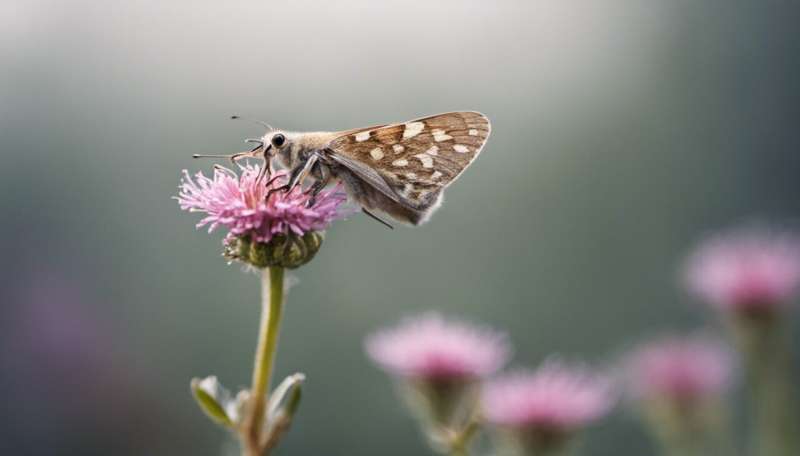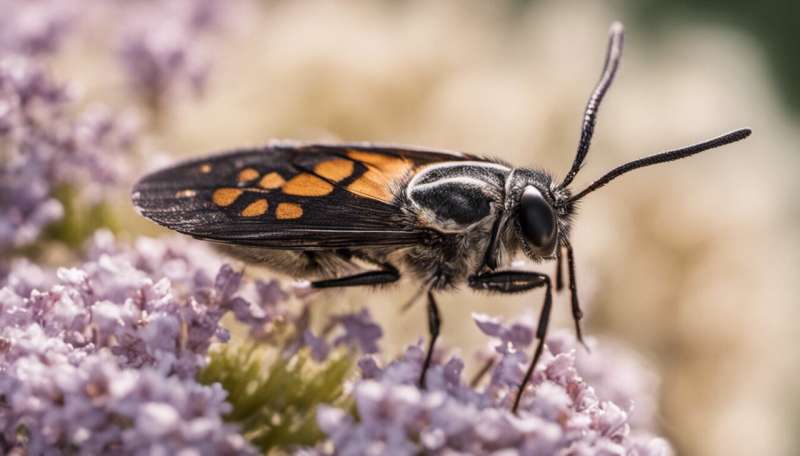This article has been reviewed according to Science X's editorial process and policies. Editors have highlighted the following attributes while ensuring the content's credibility:
fact-checked
trusted source
written by researcher(s)
proofread
Why moths might be more efficient pollinators than bees and butterflies

If you've ever felt underestimated and ignored, spare a thought for your local moths. Honeybees, bumblebees and butterflies are almost synonymous with pollination. People love them for their intimate relationship with flowers—we can't grow a lot of our food or enjoy the sight of fragile springtime blossom without them. But our recent research showed moths may actually be more efficient pollinators.
Almost all scientific research on pollinators happens during the day, which means we know little about what happens at night. So we designed a study to compare the contribution of nocturnal and day-active pollinators. We focused on bramble, which is widespread across Europe.
People often look at bramble as a prickly pest that needs to be removed from our green spaces. But it is a crucial source of nectar and pollen for bees, butterflies and moths, flowering from early spring through until the autumn.
During peak summer in the UK, when we carried out our experiment, the night is only around one-third of the entire day cycle. During this time, moths are almost the only insects that visit flowers. Even though 83% of all flower visits in our study happened during the day, pollination rates were higher at night time. This suggests moths are more efficient pollinators than species that are active during the day.
We used trail cameras to record visitors to bramble flowers over three days and placed special bags over the flowers so we could compare their pollination rates. One group of flowers was covered for the whole three days. The second group was covered only during the day time and a last set was covered only at night. It wasn't possible to identify the species of every moth that visited the flowers, but among them were silver Y and large yellow underwing moths, which are both in the family Noctuidae.
While it remains unclear precisely why moths had higher pollination rates, it may be that they spend more time visiting each flower than honeybees, hoverflies and other daytime pollinators. In any case, it's certain that the importance of moths as nocturnal pollinators is undervalued. Despite the fact there are only 60 species of butterfly and over 2,500 species of moth in the UK, a far higher proportion of research and environmental policies focus on butterflies.
Our study showed that the pollination of valuable crop plants and threatened species of wildflowers may rely upon on moths. Many of the UK's macro-moths (which tend to be larger) are declining, with over 40% of species declining in abundance.
Under pressure

Moths face the same challenges as daytime pollinators, such as pesticides, habitat loss and climate change. But nocturnal moths are also threatened by artificial light at night. Recent research has highlighted how street lighting is disrupting the feeding behavior of caterpillars and reducing moth numbers. Previous work has also shown the light disrupts adult moths from feeding, breeding and laying eggs.
Moths are not only important pollinators—they are key links in the food chain and shape the structure and composition of habitats. Their caterpillars feed on grasses and other plants. When caterpillars are dispersed throughout a habitat, some areas are grazed and others are not, which creates a varied structure. This variety bodes well for biodiversity, by creating a greater range of habitats for different species to live in. Not to mention the importance of moths as a vital food source for bats, birds and other small mammals.
New approaches to research are being developed and tested, which will help address gaps in our understanding about the role of moths as important pollinators.
For example, automated identification and tracking of insects through machine learning can allow us to remotely monitor pollinator activity, saving time in collecting and processing data. Understanding more about moths will give us the knowledge we urgently need to protect them.
What you can do
You can help these pollinating insects by allowing some patches of bramble and other flowering, scrubby plants to grow in your garden, allotments and hedgerows. You can also encourage your council to do the same across the network of road verges and parks in the UK.
The harmful effects of artificial light can be managed by dimming or limiting the operating time of street-lighting during the night, as pioneered by Devon and some other district councils. At home, you can switch off or reduce the use of outdoor lights at night and close your curtains and blinds to prevent light from spilling outside. Tackling light spill from shop fronts and glass office blocks could also help moths stay focused on pollination.
In light of the huge declines in populations of pollinating insects across the globe, it's more important than ever to protect our pollinators. These small and simple changes will provide more homes for wildlife. Spreading the word could have a crucial impact on moth conservation—some of the most underappreciated and important animals on our planet.
Provided by The Conversation
This article is republished from The Conversation under a Creative Commons license. Read the original article.![]()



















